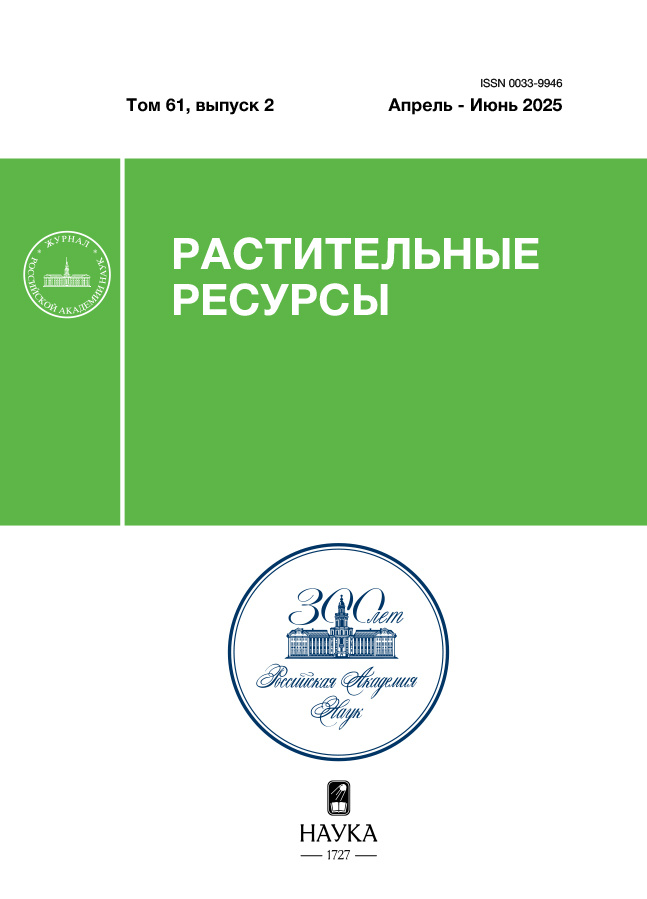Conservation of the vulnerable species Oxytropis chankaensis (Fabaceae) using in vitro culture
- Authors: Pianova A.S.1, Berdasova K.S.1, Doudkin R.V.1, Sabutski Y.E.1
-
Affiliations:
- Botanical Garden-Institute FEB RAS
- Issue: Vol 61, No 1 (2025)
- Pages: 74-79
- Section: Biology of Resource Species
- URL: https://ter-arkhiv.ru/0033-9946/article/view/683236
- DOI: https://doi.org/10.31857/S0033994625010067
- EDN: https://elibrary.ru/EGOXWM
- ID: 683236
Cite item
Abstract
The protocol of microclonal reproduction of Oxytropis chankaensis Jurtz. (a rare endemic species of the Primorye Territory) was developed for the first time. Seeds of the second year of storage were used as primary explants. Seed germination was 36%, and viability – 75%. Cultivation was carried out on Murashige and Skoog (MS) medium. The effect of four growth regulators (6-benzylaminopurine, thidiazuron, 1-naphthylacetic acid and indolе-3-butyric acid) in concentrations from 0.5 to 2 mg/l, and of their combinations on the reproduction index and rooting of microclones in vitro was evaluated. In the studied species, the positive effect of 0.5 mg/l thidiazuron and 2 mg/l indole-3-butyric acid on the multiplication of shoots was observed. On the growth media supplemented with the above growth regulators, the reproduction index was 6 and 7, respectively. Simultaneous application of two growth regulators into the nutrient medium leads to the formation of callus tissue, subsequently vitrified. Root formation is observed on MS medium supplemented with 1 mg/l indole-3-butyric acid or 0.5 mg/l 1-naphthylacetic acid.
Full Text
About the authors
A. S. Pianova
Botanical Garden-Institute FEB RAS
Email: k.berdasova@mail.ru
Russian Federation, Vladivostok
K. S. Berdasova
Botanical Garden-Institute FEB RAS
Author for correspondence.
Email: k.berdasova@mail.ru
Russian Federation, Vladivostok
R. V. Doudkin
Botanical Garden-Institute FEB RAS
Email: k.berdasova@mail.ru
Russian Federation, Vladivostok
Yu. E. Sabutski
Botanical Garden-Institute FEB RAS
Email: k.berdasova@mail.ru
Russian Federation, Vladivostok
References
- Artyukova E. V., Kozyrenko M. M. 2012. Phylogenetic relationships of Oxytropis chankaensis Jurtz. and Oxytropis oxyphylla (Pall.) DC. (Fabaceae) inferred from the data of sequencing of the ITS region of the nuclear ribosomal DNA operon and intergenic spacers of the chloroplast genome. — Russ. J. Genet. 48(2): 163–169. https://doi.org/10.1134/S1022795411110032
- Voronkova N. M., Kholina A. B. 2010. Conservation of endemic species from the Russian Far East using seed cryopreservation. — Biol. Bull. 37(5): 496–501. https://doi.org/10.1134/S1062359010050092
- Voronkova N. M., Kholina A. B. 2017. Germination biology and seed storage of endemic species of crazyweed genus (Oxytropis DC., Fabaceae family) from Siberia and Russian Far East. — Vestnik of Far Eastern Branch of Russian Academy of Sciences 2: 23–30. https://elibrary.ru/zizpkb (In Russian)
- Malyshev L. I. 2008. Diversity of the genus Oxytropis in Asian Russia. — Turczaninowia. 11(3): 5–141. https://elibrary.ru/jvhfqv (In Russian)
- Pavlova N. S. 1989. [Oxytropis DC.]. — In: [The vascular plants of the Soviet Far East]. Leningrad. Vol. 4. P. 236–280. (In Russian)
- Pavlova N. S. 2008. Oxytropis chankaensis (Jurtz.). — In: [The Red Data Book of Primorye Terootory: Plants. Rare and endangered species of plants and fungi]. Vladivostok. P. 136–137. https://redbookpk.ru/index_plants.html (In Russian)
- Pavlova N. S., Ulanova K. P. 1971. [To the chemical study of the Far Eastern species of the genus Oxytropis DC.]. — In: [Proc. conf.: Biologically active substances of flora and fauna of the Far East and the Pacific Ocean]. Vladivostok. P. 19. (In Russian)
- Yurjeva O. V., Gamburg K. Z., Kazanovskiy S. G. 2008. Clonal micropropagation of Oxytropis triphylla (Fabaceae). — Rastitelnye Resursy 44(3): 36–40. https://elibrary.ru/julbcv (In Russian)
- Shreter A. I. 1975. [Oxytropis hailarensis Kitag. f. chankaensis (Jurtz.) Kitag. [О. oxyphylla (Pall.) DC., S.L.]]. — In: [Medicinal flora of the Soviet Far East]. Moscow. P. 163. (In Russian)
- Berdasova K. S., Pianova A. S., Kameneva L. A. 2023. The effect of abiotic factors on in vitro seed germination in Oxytropis chankaensis Jurtz., a rare endemic species of the Russian Far East. — Botanica Pacifica. 12(2): 168–171. https://doi.org/10.17581/bp.2023.12206
- Burlakova L. E., Karatayev A. Y., Karatayev V. A., May M. E., Bennett D. L., Cook M. J. 2011. Endemic species: Contribution to community uniqueness, effect of habitat alteration, and conservation priorities. — Biological Conservation. 144(1): 155–165. https://doi.org/10.1016/j.biocon.2010.08.010
- Deepa A. V., Thomas T. D. 2020. In vitro strategies for the conservation of Indian medicinal climbers. — In Vitro Cell. Dev. Biol. — Plant. 56(6): 784–802. https://doi.org/10.1007/s11627-020-10084-x
- Guo B., Abbasi B. H., Zeb A., Xu L. L., Wei Y. H. 2011. Thidiazuron: a multi-dimensional plant growth regulator. — Afr. J. Biotechnol. 10: 8984–9000. https://doi.org/10.5897/AJB11.636
- Guo B., Stiles A. R., Liu C. Z. 2012. Thidiazuron enhances shoot organogenesis from leaf explants of Saussurea involucrate Kar. et Kir. — In Vitro Cell. Dev. Biol. — Plant. 48(6): 609–612. https://doi.org/10.1007/s11627-012-9468-6
- He W., Guo B., Fan P., Guo L., Wei Ya. 2015. In vitro propagation of a poisonous plant Oxytropis glabra (Lam.) DC. — Plant Cell. Tiss. Organ. Cult. 120(1): 49–55. https://doi.org/10.1007/s11240-014-0577-2
- Murashige T., Skoog F. 1962. A revised medium for rapid growth and bio assays with tobacco tissue cultures. — Physiol. Plant. 15(3): 473–497. https://doi.org/10.1111/j.1399-3054.1962.tb08052.x
Supplementary files












